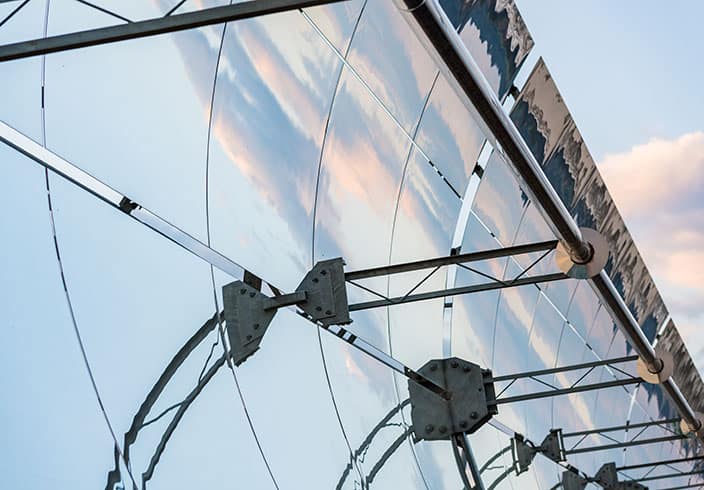Utilizing the power of the sun: especially in regions and countries with high solar irradiation, the power of the sun has long been used to generate energy in the form of electricity or heat. In view of the energy transition and the current gas crisis, renewable energy sources such as solar energy are increasingly coming into focus for the industrial sector, as well. However, especially in this context, the question of supply reliability quickly arises – after all, the sun does not shine 24/7. The ability to store solar energy is therefore essential in order to decarbonize the industrial sector and reliably supply it with energy around the clock.
System integration: How power generators and grid operators benefit from solar energy storage
Solar energy plays a decisive role with regard to achieving climate targets. In Germany, for example, the share of renewable energies in the total energy mix is to be increased to 80 percent by 2030. The goal is a reliable, flexible and sustainable power supply. For this to succeed, complete system integration is needed, from renewable generation through grid connection to end consumers.
Energy storage is an important component in this context. By storing solar energy, it can be used in a delayed manner, so that production peaks can be balanced and a flexible as well as reliable energy supply can be guaranteed. With thermal energy storage systems such as the ThermalBattery™ from ENERGYNEST, excess solar energy can be stored in the form of heat and used as part of sector coupling in the context of heat supply. Energy suppliers can thus maximize their revenues by storing previously unused green energy and using it, for example, as green process heat in industrial production. Grid operators also benefit from storing renewable energy: By balancing production peaks, existing grids can be used more efficiently. In addition, grid balancing charges are avoided.
Using solar energy in the industrial sector: Photovoltaics, Solar Thermal & Solar Power Plants
One thing is certain: The energy transition poses considerable challenges for companies. Particularly in energy-intensive industries, the rising costs of electricity and gas have already been keenly felt in recent years – and the situation has worsened considerably in the wake of the war in Ukraine. In addition to wind energy, solar energy is therefore extremely relevant for the industrial sector in order to break free from dependence on fossil energy sources and to drive electrification forward. There are various systems for utilizing solar energy.
Photovoltaics
Photovoltaic systems generate electrical energy with solar cells. he resulting DC voltage is converted by an inverter into alternating current, which can then be used directly or fed into the public power grid. Companies can thus secure their own energy supply with inexpensive green energy and even generate additional income. In combination with thermal energy storage systems, they are also able to use the energy as process heat or steam, thus ensuring the supply of their production even after sunset.
CST: Concentrating Solar Thermal
In addition to the more popular photovoltaic technology for electricity generation, concentrated solar thermal (CST) technology is used for heat generation. In contrast to photovoltaic technology, in the context of which electrical voltage is generated in the solar cells, so-called parabolic mirrors are used to concentrate the heat of the sun and make it usable as heat. With a controllable temperature between 50 and 430 degrees Celsius, this type of heat generation is also suitable for large parts of the industrial sector. If a solar thermal system is combined with an energy storage system that converts the heat into steam and releases it as needed, it is even possible to ensure a complete supply of industrial plants – even at night.
CSP: Concentrating Solar Power
The sun’s energy can also be used in solar power plants. With so-called concentrated solar power (CSP), energy storage is already possible. Up to now, molten salt energy storage systems have often been used in this context. However, storage in the form of thermal oil offers companies a much more economical solution. Here, the thermal oil is heated by concentrated solar radiation, stored and converted into steam that drives a turbine to generate electricity. In this way, electricity can be made available when needed – for example, at off-peak times. CSP plants thus become much more flexible.
Storing solar energy: A comparison between concrete heat storage and molten salt
Energy storage systems help companies to compensate for the fluctuating output of solar plants. With the help of thermal storage systems, industrial companies can draw low-cost electricity from the grid and respectively produce solar power or heat in their own plants when the sun is shining and store it as heat. There are various methods of storing the heat generated from sunlight – for example in the form of molten salt or by thermal storage in concrete. Both technologies are already being used in practice.
Thermal energy storage systems such as the ThermalBattery™ offer a number of decisive advantages, particularly compared with conventional storage systems using molten salt. Compared to oil tanks and molten salt, the ThermalBattery™ has a significantly better price-performance ratio: For example, the investment costs for the ThermalBattery are 40 percent lower compared to a system that uses liquid salt for heat storage. In terms of operating costs, the ThermalBattery™ has a price advantage of approximately 80 percent. The operation of molten salt systems is also significantly more demanding, as the salt must be kept at constant high temperatures in order to remain liquid. In contrast, both maintenance costs and complexity of the ThermalBattery™ are significantly lower, as the core of the battery is maintenance-free and requires less to no operating costs. In addition, the battery’s modular design provides better scalability as well as an easy on-site installation.
Storage for solar energy: example from practice
The ThermalBattery™ is already being used in practice: At Avery Dennison Performance Tapes’ production facility in Belgium, it helps to reliably continue production after sunset once heat generation has been switched from natural gas (NG) to concentrated solar thermal (CST).
Here, excess thermal energy from the CST system is stored in the ThermalBattery™ and released as process steam when needed, also at night. This will enable the plant to reduce its emissions even further, which, in combination with the transition to solar energy, will contribute to the company implementing its 70 percent reduction target for 2030 – and achieving climate neutrality by 2050.
Are you interested in ENERGYNEST, or have any questions regarding our thermal energy storage solutions or our applications for your specific industry?
Don’t hesitate to drop us a line.



